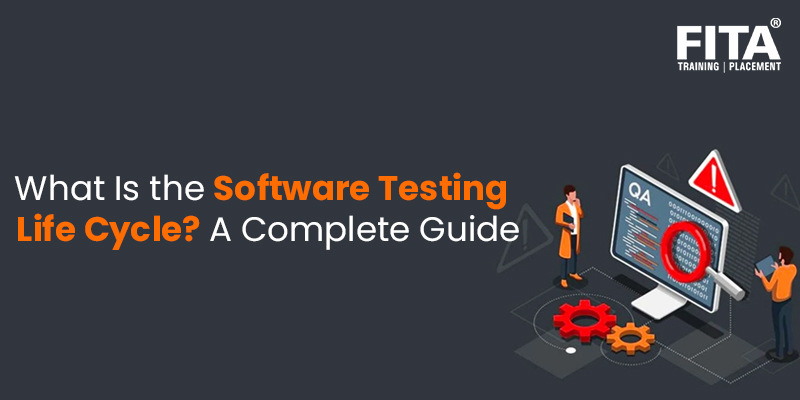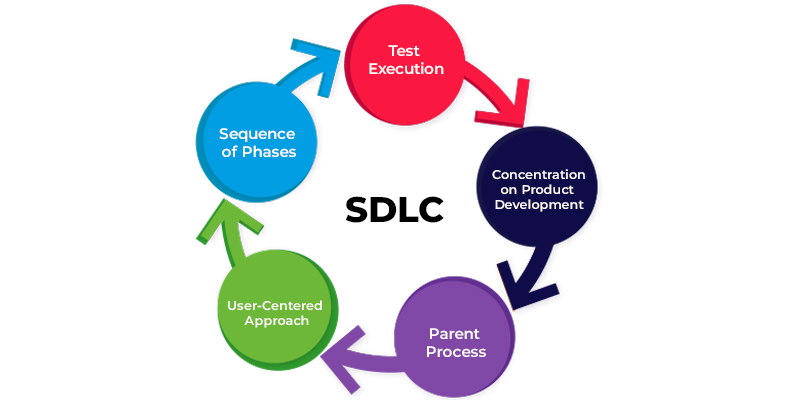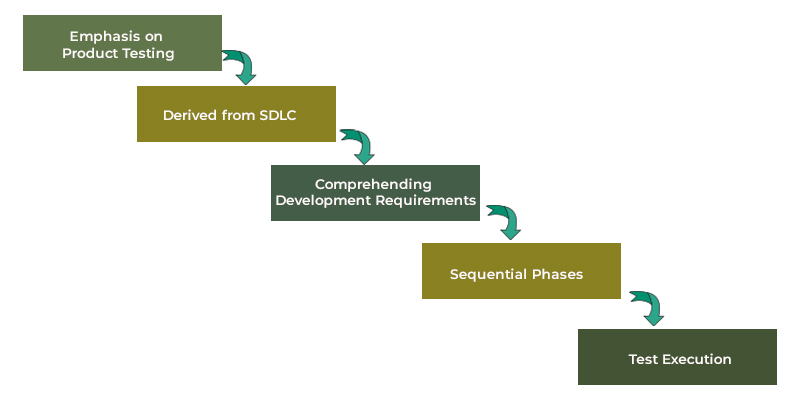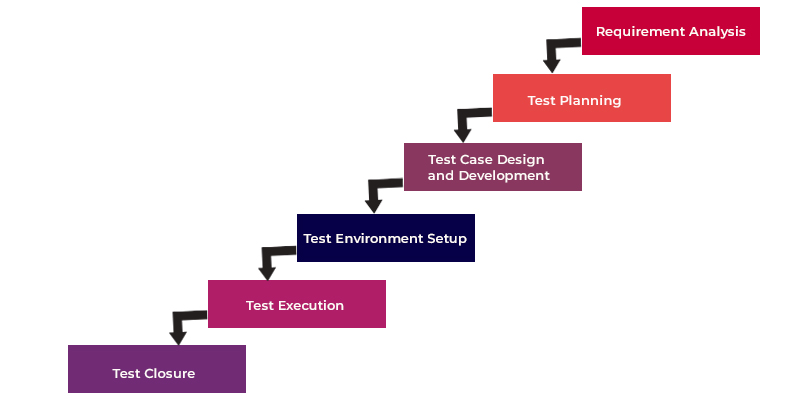
The software testing life cycle constitutes a sequential series of activities integral to the process of software testing. By adhering to a well-structured software testing life cycle, organisations enhance their prospects of formulating a robust strategy that is more likely to yield superior outcomes. The significance of this approach cannot be overstated, as it fundamentally revolves around ensuring customer satisfaction, which stands as the ultimate objective for any organisation.
One of the foremost reasons underscoring the importance of a meticulous testing life cycle is the adverse impact that a user experience marred by software glitches can have on customer satisfaction. In response to this realisation, enterprises have progressively incorporated testing as a mandatory facet of the Software Development Life Cycle (SDLC). Consequently, testing has evolved into an indispensable component deeply embedded within the operational framework of every organisation. Enrol for the Software Testing Course in Chennai and learn from the basics from our experienced trainers
With the advent of agile methodologies, the testing life cycle for applications has evolved into a more structured, process-oriented, and adaptable entity. Organisations predominantly emphasise the SDLC, often considering testing as an inherent aspect of this developmental process. Nonetheless, it is imperative for firms to recognise that software testing possesses a distinct life cycle of its own, deserving dedicated attention and a systematic approach.
What is the Software Testing Life Cycle?
A life cycle represents the progression of transformations that an entity undergoes as it transitions from one state to another. Numerous entities, both tangible and abstract, experience a series of alterations from inception to completion. In the context of the software testing life cycle, the entity in question is the software itself. The software testing life cycle comprises a structured set of procedures undertaken during the testing phase.
These procedures encompass the evaluation of the developed software to ascertain its conformity with specific requirements. When defects or issues are identified within the product, testers collaborate closely with the development team to rectify them. In certain instances, they may also engage stakeholders to gain deeper insights into various product specifications. Furthermore, the validation and verification of the product represent critical components of the Software Testing Life Cycle (STLC).
What are STLC and SDLC?
SDLC, or the Software Development Life Cycle, is responsible for managing the entire lifecycle of a product, guiding it from its initial conception to its ultimate status as a finished product. It encompasses various phases and processes, including requirements gathering, design, coding, testing, deployment, and maintenance. SDLC ensures that the software is developed efficiently and effectively, meeting user needs and quality standards.
On the other hand, STLC, or the Software Testing Life Cycle, is a subset of SDLC that focuses exclusively on the testing phase. While SDLC oversees the entire product development process, STLC is dedicated to the activities and processes involved in testing the software to ensure its quality and reliability. STLC includes activities such as test planning, test case development, test execution, defect reporting, and test closure.
The key difference between SDLC and STLC lies in their scope and focus. SDLC covers the entire product development journey, while STLC concentrates specifically on the testing phase within SDLC to ensure that the software meets the required quality standards. Join the Software Testing Course in Bangalore at FITA Academy and start your journey as a software tester today!
SDLC

Concentration on Product Development
SDLC places a strong focus on the development of a software product, serving as the overarching framework for its creation.
Parent Process
Within the software development context, SDLC acts as the primary process that oversees and coordinates the entire journey from conception to the realization of a functional product.
User-Centered Approach
SDLC involves the understanding of user requirements and actively participating in the construction of a product tailored to meet the specific needs and preferences of its users.
The sequence of Phases
The phases of SDLC, such as requirements gathering, design, and coding, are executed in a sequential manner before entering the testing phase.
Test Execution
SDLC’s ultimate goal is to facilitate the deployment of a high-quality product that is not only fully functional but also user-friendly, ensuring effective utilization by end-users.
STLC

Emphasis on Product Testing
STLC places its primary emphasis on thoroughly testing a product to ensure its functionality and reliability.
Derived from SDLC
STLC is a subsidiary process stemming from the broader SDLC framework.
Comprehending Development Requirements
STLC involves a deep understanding of the development requirements and strives to confirm that the product operates as intended.
Sequential Phases
The phases of STLC commence only after the phases of SDLC have been completed, highlighting the sequence of these processes.
Test Execution
The primary objective of STLC is to detect and identify defects or bugs within the product, subsequently reporting them to the development team for resolution. This aids in enhancing the product’s overall quality and performance.
These represent the fundamental distinctions between SDLC and STLC. Now, let’s delve deeper into the intricacies of STLC.
Overall, if you want to start a career as a software tester, Software Testing Interview Questions and Answers can assist you in improving your abilities and knowledge. This provides answers to all of the questions that may arise during your Software QA Interview.
What is the Role of STLC in SDLC?
In the previous section, we discussed that the ultimate objective of SDLC is to deploy high-quality products. However, determining and achieving high quality in a software product is a multifaceted endeavour. Quality is often measured by various factors, and achieving it is closely linked to enhancing the user experience. One critical aspect of achieving high quality is ensuring that the product functions seamlessly and meets user expectations. This is where STLC plays a pivotal role.
Within the context of SDLC, STLC serves as the mechanism to identify any elements of the product that may not be performing smoothly or as anticipated. STLC then serves as the bridge to communicate these issues to the development team for necessary updates and refinements.
Now, delving deeper into why STLC is indispensable: Even when a company employs highly skilled programmers and developers, human errors are inevitable. The primary function of STLC is to unearth these errors and facilitate their rectification. The principal aim of conducting STLC is to consistently uphold product quality, ensuring that it aligns with user expectations and functions without flaws.
Each phase of the product development process, from initial planning and research to execution and ongoing maintenance, holds a pivotal role in the comprehensive testing of a product.
STLC is fundamentally dedicated to ensuring and affirming the quality of the product. Different applications possess distinct attributes, including reliability, functionality, and performance, and STLC serves as the instrumental process for enhancing these attributes. It acts as the catalyst for delivering a final product that aligns with the desired quality standards.
Notably, a high-quality product yields substantial benefits in terms of long-term cost savings for maintenance. The stability of an application or software is imperative for attracting new users, and it also plays a pivotal role in retaining existing clientele. To sustain a product’s presence and competitiveness in the business landscape, it is imperative to diligently address each phase of the STLC. This comprehensive approach ensures the product’s continued success and reliability.
What Are the Phases of Testing?

It is imperative to validate each module of software or an application to ensure the precision and accuracy of the product. Given the intricate nature of software testing, it is systematically conducted in the following phases:
- Requirement Analysis
- Test Planning
- Test Case Design and Development
- Test Environment Setup
- Test Execution
- Test Closure
The absence of organised testing can lead to complications, including unresolved bugs, overlooked regression issues, or even the omission of testing for certain modules due to impending deadlines.
Each phase within the Software Testing Life Cycle (STLC) possesses specific objectives and deliverables, guiding the inception, execution, and conclusion of the testing process. In the subsequent sections, we will delve into each of these phases of the STLC in greater detail.
- Requirement Analysis
During the Requirement Analysis phase, software testers play a crucial role in thoroughly reviewing, studying, and evaluating the available specifications and requirements. Notably, some requirements lead to specific outcomes when provided with input data, making them testable requirements. Testers meticulously examine both functional and non-functional requirements, followed by the identification of those that are testable.
Key activities in this phase encompass brainstorming for requirement analysis, the identification and prioritisation of test requirements, and the selection of requirements suitable for both automated and manual testing. Additionally, certain universal tests are conducted, even if not explicitly mentioned, such as verifying that an active button triggers a response and that a phone number text field does not accept alphabetic characters.
However, the requirement analysis phase primarily focuses on acquiring specific insights into the product’s functionality and characteristics in its optimal state. This phase yields essential deliverables, including a comprehensive requirements report and an assessment of test automation feasibility.
Another critical output of this phase is the creation of a requirements traceability matrix. This matrix enables the tracking of artefacts back to their originating requirements. Essentially, it ensures that every testing activity is linked to a requirement that contributes value to the customer, minimising waste and enhancing efficiency.
To summarise:
- Understand the expected product output.
- Identify any discrepancies in the specifications.
- Establish priority levels for requirements.
- Conduct feasibility assessments for test automation.
- Test Planning
The Test Planning phase follows Requirement Analysis and involves the Quality Assurance (QA) team in crafting a comprehensive testing plan. This plan is developed after a thorough analysis of all testing prerequisites. It outlines the scope and objectives of testing, drawing upon a deep understanding of the product domain. Risk analysis is conducted to identify potential challenges, and a strategy is formulated.
In this phase, the team defines time schedules and sets up testing environments. Additionally, management makes final decisions regarding the tools to be employed and assigns specific roles and responsibilities to team members. A tentative timeline is established to guide the completion of testing for each module. The primary deliverable of this phase is the test plan document, which provides a detailed account of the rationale and specifics of the testing activities for the project. Learn the Software Testing Course in Delhi and become a pro!
In summary:
- Prepare documentation for the test plan.
- Estimate time and resource requirements.
- Confirm the selection of tools and platforms.
- Assign tasks to teams and individuals.
- Identify any training needs.
- Test Case Designing and Development
Following the stages of development and planning, the creative process begins. Based on the test plan, testers initiate the design and development of test cases. These test cases are meticulously crafted to ensure comprehensive coverage of nearly all conceivable scenarios. All relevant permutations and combinations are diligently compiled.
Test case prioritisation is conducted by assessing which cases are most prevalent or possess the potential to have the greatest impact on the product. Subsequently, the validation and verification of specified requirements are undertaken during the documentation stage. Additionally, the review, enhancement, and approval of both automation scripts and test cases are integral components of this phase.
This stage also entails the definition of various test conditions, complete with input data and expected outcomes. The primary deliverables from this phase are the actual test cases, systematically organised within their respective test suites.
In summary:
- Conduct research to identify possible actions on the product.
- Develop comprehensive test cases.
- Prioritise test cases based on importance.
- Create and refine automated scripts for test cases.
- Test Environment Setup
Effective testing activities rely on specific environmental factors, including servers, frameworks, hardware, and software, to execute the developed test cases. Ensuring the readiness of the test environment is paramount, including conducting initial smoke tests and equipping testers with bug-reporting tools. It is a common scenario in the developer community to hear phrases like “It worked on my system but not on yours.”
Therefore, it is vital that the test environment mirrors the diverse environments that end-users may utilise. For instance, a feature that functions smoothly in Google Chrome may encounter issues in Internet Explorer. Similarly, a feature may operate flawlessly on a system with 4 GB of RAM but experience problems on one with only 1 GB of RAM. Conducting research into the environments used by end-users aids in prioritising the setup of test environments.
The primary deliverable in this phase is a comprehensive strategy for test environment management. The responsibility of setting up the test environment typically falls to the QA manager overseeing the testing team.
To summarise:
- Understand the minimum requirements for the test environment.
- Compile a list of required software and hardware for various performance levels.
- Prioritise the setup of test environments based on end-user needs.
- Actively configure and prepare the test environments.
- Conduct initial smoke tests to ensure the functionality of the built environments.
- Test Execution
Upon completing the preceding phases, the application is primed for testing. In accordance with the test plan, testers initiate the execution of test cases. During this phase, they meticulously identify, detect, and record defects, thereby reporting any encountered bugs. Additionally, the team conducts a comparison between the expected results and the actual outcomes. Any identified defects are meticulously documented and forwarded to the development team for resolution.
Subsequently, after the development team addresses a bug, the process of regression testing commences. Regression testing aims to ensure that the software or application continues to function properly even after changes have been deployed. When conducting tests following a bug fix, it is imperative to scrutinise the entire product anew. This is essential because a bug fix in one part of the product may inadvertently introduce a bug elsewhere.
Given the repetitive nature of running the same tests after each fix and deployment, it is advisable to employ scripts or automated testing tools. The primary deliverables in this phase are the test results, which are ideally validated and communicated in an automated fashion.
To summarise:
- Execute test cases according to the test plan.
- Identify deviations from the expected product behaviour.
- Log details of failed test cases.
- Perform regression testing after bug fixes.
- Test Closure
The final phase of the STLC is the test closure phase, which commences after the completion of test execution and the delivery of the end product. In this phase, the QA team scrutinises the test results and engages in discussions with team members. Various factors are considered, including product quality, test coverage, and project cost. If there are discrepancies from the estimated values, further analysis is conducted to pinpoint areas where expectations were not met.
It is essential for testers to convene and engage in a comprehensive discussion after the testing process. During this discussion, any challenges encountered during testing, shortcomings in strategies, and lessons learned are reviewed. This phase also provides an opportunity to brainstorm and devise improved testing approaches based on the insights gained during testing. For teams following DevOps or canary release practices, where testing is frequent, decisions regarding the frequency of reporting and the specific details to include in reports for different stakeholders are made.
Moreover, the team evaluates various test metrics, assesses the achievement of goals, and examines adherence to project timelines. With a comprehensive understanding of the testing process, the team can evaluate the overall testing strategy and process.
To summarise:
- Verify the completion of all test cases.
- Assess factors such as product quality, test coverage, timeline, and cost.
- Document the conclusions drawn from the testing process.
- Discuss lessons learned and potential improvements in the testing process.
- Prepare a test closure report.
What Are the Entry and Exit Criteria for Testing?

In the intricate landscape of software testing, the software testing life cycle meticulously navigates through six distinct phases, each meticulously bound by a set of entry and exit criteria. This essential framework serves as the cornerstone for assessing the quality, performance, and functionality of the end product. It is imperative for testing teams to operate within strict time constraints, all the while safeguarding the integrity of the software.
The establishment of clear and unequivocal entry and exit criteria stands as a paramount responsibility. These criteria act as the threshold for embarking on each phase of the testing journey and subsequently concluding it. They act as the litmus test for the readiness and progression of the software under evaluation.
The significance of this process cannot be overstated. Entry criteria mark the commencement of a testing phase, ensuring that the prerequisites and prerequisites are satisfactorily met before diving into the rigorous testing activities. Conversely, exit criteria signify the culmination of a phase, certifying that the intended objectives and goals have been achieved.
In essence, the strategic definition and judicious application of these criteria are indispensable for orchestrating an efficient and effective software testing life cycle. They are the cornerstones that uphold the overarching goal of delivering a robust, high-quality software solution.
Entry Criteria
Entry criteria delineate the specific requirements that must be fulfilled before initiating the testing process. It is imperative that all prerequisites are satisfied prior to commencing testing activities.
Several ongoing activities and conditions must be in place before testing can commence. These include obtaining input and cooperation from the development team, thorough examination and validation of the test plan, test cases, and test data, ensuring the readiness of the testing environment, and confirming the availability of the code to be tested. These criteria serve as essential prerequisites to ensure the smooth initiation of the testing phase. Join the Software Testing Course in Kochi and understand and learn with real world scenarios with our experienced trainers
Exit Criteria
Exit criteria outline the specific requirements and actions that must be fulfilled to conclude the testing phase. In essence, they encompass the tasks and processes that need to be completed before testing is officially concluded.
Among the various elements included in exit criteria is the identification and resolution of high-priority defects. Immediate attention and resolution of these defects are imperative. Additionally, exit criteria encompass the successful execution and completion of various test cases, ensuring comprehensive functional coverage. These criteria serve as the benchmarks to be met before officially concluding the testing process.
Merely identifying errors in the final stage of an SDLC is no longer an efficient practice. In today’s fast-paced business environment, organisations must allocate their time and resources to a multitude of daily activities. Overcommitting to testing and bug-fixing can impede overall efficiency, ultimately resulting in longer timelines and reduced productivity.
To streamline the testing process, it is imperative to optimise the utilisation of time and resources. Adhering to a systematic Software Testing Life Cycle (STLC) not only facilitates expedited bug resolution but also elevates product quality. This, in turn, leads to heightened customer satisfaction, increased return on investment (ROI), and an enhanced brand presence. The efficient utilisation of STLC not only enhances the testing process but also contributes to broader business success.
